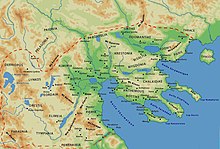Apollonia Mygdoniorum
Apollonia ( ancient Greek Ἀπολλωνία ) was an ancient city in Macedonia ( Greece ).
Based on ancient mentions and finds, the city is located in the plain south of Lake Bolbe and was thus in the Mygdonia landscape . Earlier attempts to locate another city with the name Apollonia in the central area of the Chalkidike peninsula near today's Polygyros are rejected by the current research.
history

The beginnings of Apollonia probably go back to the 5th century BC. BC back. On the eve of the Peloponnesian War , the Macedonian king Perdiccas II supported 432 BC. Chr. The secession of Chalcidian cities from the Attic League . This was done with the intention of breaking the Athenian position of power on the northern edge of the Aegean Sea . If the rebellion for Macedonia was successful, it was necessary to protect the inhabitants of the coastal cities from the Athenian naval force. For this reason, Perdiccas II made land south of Lake Bolbe available to the Chalcidians as a retreat for the duration of the war. It was probably during this time that the resettled Chalkidians founded Apollonia, which is also confirmed by coin finds. 404 BC The Peloponnesian War ended with the defeat of Athens by its rival Sparta. Macedonia also suffered due to the confusion of the throne at the beginning of the 4th century BC. A period of weakness. Apollonia apparently took advantage of this power vacuum and thus gained independence. The minting of our own copper coins are evidence of this development.
However, independence was achieved in 382 BC. Chr. Questioned by the Chalcidian city union with the hegemon Olynth . The Chalcidian city union was at the beginning of the 4th century BC. BC rose to an influential power factor in northern Greece but came into conflict with Macedonia due to territorial disputes. In order to gain support in the fight against Macedonia, the Chalcidian alliance of cities called Apollonia and Akanthos, located on the east coast of Chalkidike, to join the alliance. Since this would have meant the loss of independence, both cities sent envoys to Sparta, the most influential power in Greece at the time, to ask for help. Since Sparta did not want to tolerate an increasingly powerful Chalcidian alliance, troops were sent north to support. In the Olynthian War 382–379 BC BC Olynthos had to capitulate and recognize the autonomy of Apollonia.
Since the Macedonian king came to power in 359 BC BC Philip II , the Macedonian influence in Greece grew noticeably. In the course of the territorial expansion of Macedonia and the conquest of the Athenian colony Amphipolis in 356 BC. Apollonia lost its independence and became part of Macedonia again.
315 BC Apollonia lost most of its inhabitants to the foundation of the city of Thessaloniki by the Macedonian king Kassander . During the Roman Empire , the city served as a stop on the route from Amphipolis to Thessaloniki and was temporarily the seat of a bishop. The apostle Paul of Tarsus is said to have stopped by here on his second missionary trip. In today's place Apollonia , which is about 2.5 km to the north, is the place where Paul preached before the congregation of Apollonia.
In 2000 a farmer found a golden wreath while plowing. Archaeologists examined the site more closely and found a Macedonian grave and 16 simpler graves. They also discovered the foundation walls of the city fortifications of Apollonia. The golden wreath and four gold coins from the time of Alexander the Great are exhibited today in the Thessaloniki Archaeological Museum .
literature
- Michael Zahrnt : Olynthos and the Chalkidians. Studies on the formation of states on the Chalcidian Peninsula in the 5th and 4th centuries BC Chr. (= Vestigia. Volume 14). Beck, Munich 1971, ISBN 3-406-03097-1 , pp. 155-158.
- Michael Zahrnt: Apollonia. In: Siegfried Lauffer (Ed.): Greece. Lexicon of Historic Places. From the beginning to the present. Beck, Munich 1989, ISBN 3-406-33302-8 , p. 125.
- Gustav Hirschfeld : Apollonia 3 . In: Paulys Realencyclopadie der classischen Antiquity Science (RE). Volume II, 1, Stuttgart 1895, column 114.
- Gustav Hirschfeld: Apollonia 4 . In: Paulys Realencyclopadie der classischen Antiquity Science (RE). Volume II, 1, Stuttgart 1895, column 114.
Remarks
- ↑ Michael Zahrnt : Olynth and the Chalkidians. Studies on the formation of states on the Chalcidian Peninsula in the 5th and 4th centuries BC Chr. Munich 1971, pp. 155–157.
- ↑ Demosthenes : Third speech against Philip , 9, 26; Demosthenes: Speech On Halonnesus , 7, 28
- ↑ Acts 17 : 1
- ↑ ANCIENT MACEDONIAN CITY DISCOVERED BY ARCHAEOLOGISTS NEAR NEA APOLLONIA THESSALONIKI
- ^ Andreas Neumeier, Peter Chancellor: Northern and Central Greece. Erlangen 2016, p. 416.
Coordinates: 40 ° 37 ′ 23 " N , 23 ° 27 ′ 59" E